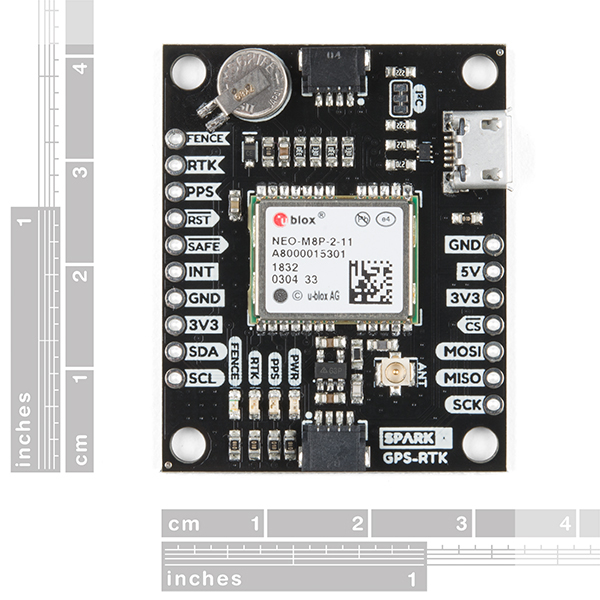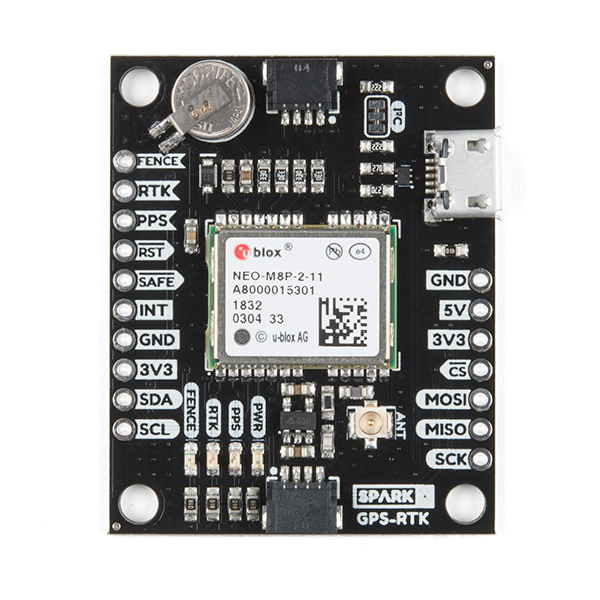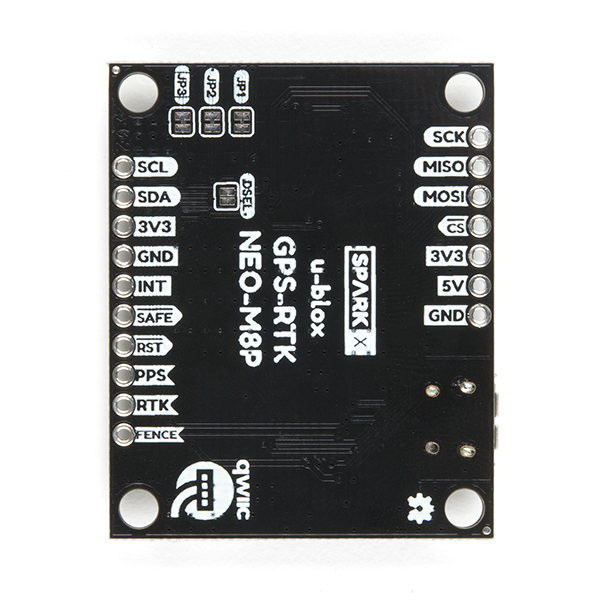Ublox GPS-RTK (Qwiic) - NEO-M8P-2
This product has been replaced with a fancy red version. Everything is the same except the red version has better TX/MISO and RX/MOSI pin labels, and better hookup guide documentation.
Thanks to GPS you can quickly know where you are anywhere on the globe within 30 seconds. Pretty impressive! But what if you need better accuracy than the 2.5 meters accuracy that GPS provides? GPS Real Time Kinematics (RTK) has 25mm accuracy. You can now know where you are (or any object) within one inch.
The SparkFun GPS-RTK board is a powerful breakout board for the the NEO-M8P-2 module from Ublox. The NEO-M8P-2 module is the top-of-the-line module for high accuracy GNSS and GPS location solutions including RTK. The NEO-M8P-2 is unique in that it is capable of both rover and base station operations. The ‘-2’ designation means this module has survey-in mode allowing the module to become a base station and produce RTCM 3.x correction data.
The GPS-RTK has four communications ports:
- USB (enumerates as a COM port)
- UART (3.3V TTL)
- I2C
- SPI
The USB and UART ports are common and well documented. We've also written an Arduino library for Ublox modules to make reading and controlling the GPS-RTK over Qwiic a breeze.
We've even included a rechargable backup battery to keep the latest module configuration and satellite data available for up to two weeks. This battery helps 'warm-start' the module decreasing the time-to-first-fix dramatically.
We've written multiple tutorials to get you started:
The number of configuration options of the NEO-M8P-2 is incredible! Geofencing, variable I2C address, variable update rates, even the high precision RTK solution can be increased to 4Hz. This is a powerful module.
What can we do on the next rev of this product to make it better? (a one question google form)
Experimental Product: SparkX products are rapidly produced to bring you the most cutting edge technology as it becomes available. These products are tested but come with no guarantees. Live technical support is not available for SparkX products. Head on over to our forum for support or to ask a question.
- Weight: 6.3g
- Dimensions: 1.6x1.3"
- Voltage: 5V or 3.3V but all logic is 3.3V
- Current: approximately 35mA (varies with constellations and tracking state)
- Time to first fix: 29s (cold), 1s (hot)
- Max Navigation Rate:
- PVT (basic location over UBX binary protocol) - 10Hz
- RTK - 5Hz
- Moving Baseline RTK - 4Hz
- Raw - 10Hz
- Horizontal Position Accuracy:
- 2.5m without RTK
- 0.025m with RTK
- What is GPS RTK?
- GPS-RTK Hookup Guide
- Using U-Center to configure the NEO-M8P for base station RTCM output
- SparkFun GPS-RTK Schematic
- NEO-M8P-2 Datasheet
- NEO-M8P Hardware Integration Manual
- NEO-M8P Product Summary
- Ublox M8 series protocol
- Ublox white paper on using low cost antennas for RTK
- Example RTCM output from the NEO-M8P-2
- SparkFun Ublox Arduino Library for reading NMEA and sending UBX commands over I2C. Can also be installed using the Arduino library manager by searching 'SparkFun Ublox'
- Check the hardware repo for the latest Eagle files
- Ublox ECCN notice
Ublox GPS-RTK (Qwiic) - NEO-M8P-2 Product Help and Resources
What is GPS RTK?
September 14, 2018
Learn about the latest generation of GPS and GNSS receivers to get 14mm positional accuracy!
GPS-RTK Hookup Guide
September 13, 2018
Find out where you are! Use this easy hook-up guide to get up and running with the SparkFun high precision GPS-RTK NEO-M8P-2 breakout board.
Getting Started with U-Center for u-blox
September 13, 2018
Learn the tips and tricks to use the u-blox software tool to configure your GPS receiver.
Comments
Looking for answers to technical questions?
We welcome your comments and suggestions below. However, if you are looking for solutions to technical questions please see our Technical Assistance page.
Customer Reviews
5 out of 5
Based on 1 ratings:
Really good board to get into the world of survey grade (~2cm/1in) GPS/GNSS
This is an excellent board to get into the world of real-time or post-processed (using RTKlib) survey grade GPS/GNSS with about 2cm (1in) precision. The USB port is very convenient for anyone wanting to get started with a laptop/Raspberry Pi: no need for any extra electronics other than an antenna. The bad news is the price. It was originally $150 and at the time of writing is now $200 per board. But this still represents excellent value for money given that the core uBlox M8P-2 modules themselves seem to be priced at over $150 in small quantities. Also, chances are that you will need two of them to use in RTK mode: one for base station, the other for the rover. If you are not familiar with this technology you need to be patient: there is some setting up to do (antennas, piping a correction signal from base to rover etc) and it may take some experimentation before you get your first super-accurate RTK fix. I can confirm that in that mode I see ~2cm precision with these boards.
The tiny u.fl antenna connector is a pain. I can see why it's used: it's cheap and offers flexibility on where the module is mounted on the PCB. But it means you need a fragile 'pig tail' adapter to mate with the SMA connector that most antennas come with.




